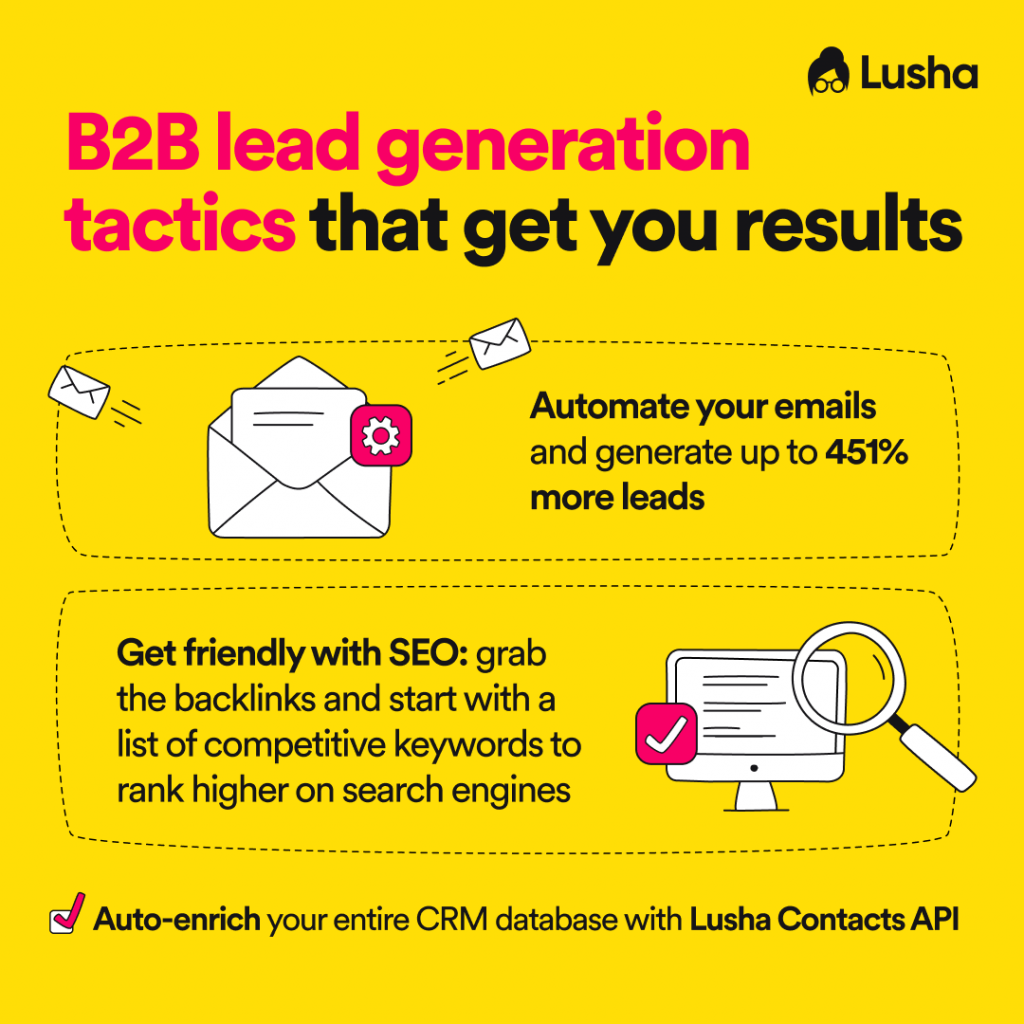B2B lead generation is so hard to crack. So, where do you start? Get off the hamster wheel quickly. Stop wasting too much time on marketing and prospecting activities. Put your hard-earned efforts into selling instead.
It’s simple. B2B lead generation works like a charm when marketing and sales are aligned and consistent. You’re going to have to step out of your comfort zone and get bold if you want to succeed. Here are some of our favorite tactics to help you get up to 4X more leads That’s right! You could potentially quadruple your lead generation with these awesome tips from our A- team, sales team.
What is B2B lead generation?
B2B lead generation is when marketing and sales teams identify their ideal customer or accounts, create and execute strategies to build interest. The goal is to get them to fill in their contact details on a lead form to then qualify as a relevant lead and nurture them down the sales funnel. It’s a lot to pull together. To do it well, you need a rockin’ plan. Running a business without a B2B lead generation strategy is like setting a new year’s resolution to get fit without a workout plan. Without one, you won’t win consistent sales, scale your business, or be able to predict future revenue.
Why B2B lead generation needs SEO
Did you know? 57% of B2B professionals think SEO generates more leads than any other marketing initiative. That’s quite the number. Do you have the talent and resources to improve your search rankings, get more backlinks, research, and optimize keywords to drive relevant leads to your site? No. Wake up! It’s 2022 – go with SEO all guns blazing or lose.

The Five Foundation Stones of Lead Generation
These are my top five ways to create traffic to your website, and how to leverage that traffic for lead generation.

1. Email Marketing
It’s still the best lead generation strategy out there for communicating with your target audience. It’s how 72% of all US adults prefer to receive information from companies, according to MarketingSherpa’s findings. It’s fast, efficient, inexpensive, tried and tested, with no signs of fatiguing the customer. Email marketing is the foundation stone of every marketing campaign and is easy to track, measure, test and tweak. For B2B audiences, email marketing is the third most influential source of information. (Colleague recommendations come in at first place with industry-specific thought leaders taking second.)
How to generate leads: With email marketing, you already have some contact details, but want to move your prospects further down the funnel. Most of the time you’ll send your list “soft” content, like newsletters or blog updates, which can also include some commercial calls to action (which many users will ignore). When the time feels right, you can send a promotional email which encourages the user to deepen the relationship. For example, the email can offer a downloadable report, asking users for more contact details or asking them about specific purchase intent.
2. SEO
Search Engine Optimization is often punted as a complex process that requires specialist knowledge to rank high on SERP’s (search engine results page). In reality, it’s not so difficult to understand.
According to Outbrain, search engines drive 300% more traffic to websites than social media.
Your potential customers approach a search engine with an intention. They seek out the relevant information using keywords. When their keywords and yours align, a relationship can begin. We know that over 60% of clicks favor one of the top three websites on the search engine results page, according to the Search Engine Journal. You can bet that those sites that organically rank on the top of the results page have done their keyword research homework and know exactly which keywords their target audience is using to find products in their niche.
The use of keywords (including long tail and LSI keywords) is the essence of SEO campaigns. 50% of search engine queries (keywords) are four words or longer. Your lead generation strategies for SEO will entail finding keywords with a high search volume, with low competition and that are relevant to your business. This will increase website traffic, generate quality leads and ultimately increase sales or conversions.
Great SEO also incorporates high-quality content that is posted consistently and uses keywords strategically (that is, not keyword stuffing). Link building is also an essential element of SEO. You want industry leaders or authority sites to backlink to your content to give it credibility and boost your relevancy reputation in the eyes of the search crawlers.
How to generate leads: Good SEO will generate relevant traffic. It’s not trivial to translate that traffic into leads. One approach is to build organic traffic to your “money pages.” For example, a product page, landing page with gated content, or sign up page – this is powerful but quite difficult to achieve. An easier and more scalable approach is to drive traffic to generic content, such as blog posts, which are related to your brand and encourage users to convert – for example, by signing up to your blog feed, downloading an asset, or even requesting a demo of your product.
3. Paid Traffic
Here you are paying for online advertising that drives leads to your website. The most popular types of paid lead generation advertising include:
- Display ads that pop up on the side of your page.
- Paid search using Google AdWords (PPC, PPV, PPA, or flat rate).
- Social media advertising on Facebook,creating a LinkedIn lead generation strategy, YouTube, Twitter, and Instagram.
- Paid discovery is used to get your content promoted on other sites like StumbleUpon or Outbrain Amplify.
- Sponsored content (native advertising) that disguises your product pitch in an engaging article.
- Influencer marketing is where you pay a social media influencer, with loads of followers, to promote your brand/product/service.
How to generate leads: Almost all paid campaigns are intended to generate leads. Paid traffic is typically aimed at landing pages with forms, and the KPI for success is how many users fill out those forms to become leads – and the ultimate quality of those leads. Paid campaigns that are worth anything will generate leads, and you need to weigh the cost per lead (CPL) vs. the quality of those leads. To evaluate lead quality, look at the data and try to see if the people who came in through paid campaigns are your buyer persona. You can use data enrichment tools to learn more details about your contacts, for example, their geography, job description or the company they work for.
4. Social Media Marketing (SMM)
You are using social media channels to increase your website traffic and improve lead generation. You will be crafting unique content that can be tailored to the specific platform’s context to ensure your content gets shared and users interact with your posts. Social media platforms are used by a large and growing fraction of the world’s population – as of late 2017, Facebook had over 2 billion active users – approximately 1 of 3.5 people in the world of all ages – while YouTube has 1.5 billion and WhatsApp reports 1.3 billion. LinkedIn has only 106 million users, but is by far the most important for B2B marketers, as these are professional users who advertise the companies they work for, their job descriptions, skills and professional interests.
SMM helps you to speak directly to your audience where they are interacting. Innovative marketing on social media can result in devoted followers and should be one of your key lead generation strategies.
How to generate leads: There are ways to generate leads directly in social media platforms. For example, Facebook, LinkedIn, and Twitter offer paid advertising options which allow you to display a form after users click an ad and collect lead information, without asking users to leave the social network. It is also possible to create customized landing pages with conversion outlets as part of a Company Page on LinkedIn or Facebook. The last option is relying on traffic that flows from social to your website, and convincing those users to convert into leads. This last option is difficult to achieve because only a small fraction of social followers will visit your website and only a small fraction of those will actually convert.
5. Content Marketing
Your content has to be of the highest value to your target audience. Quality content is the driving force in all marketing campaigns – it assists with gaining buyer’s trust, and can differentiate you from the marketing noise. If you generate high-quality content, the search engines will also reward you with a higher ranking in SERPs because you are providing a better UX. It is vital to provide content that is valuable, not promotional, so you are viewed as a thought leader in your industry. When you are constantly providing a trusted voice and exceptionally valuable content, you ‘own’ your audiences’ attention.
How to generate leads: Content is a companion for almost all lead generation campaigns (for example, a paid search campaign can take users to a landing page and a downloadable eBook, both of which are content pieces). But content can also be used directly to generate leads. When you are consistently creating good content on a blog or other online platform, that content will start to receive traffic through search engines, links from other websites and regular visitors. Adding relevant calls to action, ads, and popups as an integral part of your pages, will help you turn some of that traffic into leads.
13 piping hot B2B lead generation tips
1. Automate the right things—but don’t go overboard
Marketers who use automation to nurture leads see a 451% increase in qualified leads. Look at it this way, If leads are the water in your marketing funnel and sales pipeline, automation is the pump that keeps it flowing. When the right activities are automated, teams can bring in a larger volume of leads, spend more time on revenue-driving activities (like selling), and remain more productive.
Kick start automation into motion by:
- Launching digital marketing campaigns
- Sending email marketing sequences
- Posting chewable content on social media
- Sales outreach and follow-up messages
- Lead scoring, routing, and qualification
- Updating your database on a regular basis
- Reviewing and updating your lead generation tools
Let’s dig in and zoom in on your CRM a sec. Is your database automatically? No? Yikes. Manual entry takes forever and at one point you’re going to end up entering the wrong data. If you’re updating every quarter you could be selling with inaccurate data. You need to fix all that fast, like right now.
Tip: Lusha API bulk-enriches your entire CRM with one-click. It provides you with accurate contact information like phone numbers, email addresses, and job positions as soon as it’s updated. When you have all these activities on autopilot, your team can explode its B2B lead generation process, setting new records for lead reach and volume year after year.
Don’t set it and forget it with B2B lead generation
What happens when automation goes left? Automating everything can backfire on you, potentially causing you to lose leads and sales.
Picture this: A marketing agency manager is shopping around for account-based marketing software for 10 of her enterprise clients. She finds the exact tool they need and requests a demo. But she immediately gets an automated email response that her company has been disqualified. Why? Because the agency’s size doesn’t match the ideal customer profile (ICP).
Do you see the problem here? Although the agency didn’t match the ICP, 10 of their clients do. It’s annoying for the marketing agency manager, but the real losers are the sales team. They just lost 10 potential customers because they completely relied on automation.
Tip: Be extra careful with lead qualification. You’ll have to apply both manual and automated processes to prevent losing sales.
2. Tune in prospects with a podcast
2022 will see a whole lot more podcasts in the B2B world. 90% of podcast listeners tune in from the comfort of their own homes. The average listening time is roughly 6 hours and 39 minutes each week. Now, how many hours does a salesperson spend prospecting on social media each week? Do you get the picture? With podcasts, you can reach your prospects at any random pocket of free time during the day. That kind of connection is too good to miss. Don’t give in because:
- “There’s too much competition” In 2021, there were 500 active blogs compared to the ‘big three’ podcast platforms, Apple, Spotify, and Google, which have only 1.7 million active podcasts between them. If you narrow it down to your industry or niche, the podcast competition is probably not as bad as you think.
- “You don’t have the right talent” Podcasting is all about understanding your listeners (AKA potential customers) better and creating episodes around topics that will help them. Check out your competitors’ podcasts. You’ll be surprised to find that many started off with audio issues, poor consistency, very little promotion, distribution, or reviews to drive SEO. In the end, they still managed to build a successful following. Find your best speaker and start answering the questions your audience is asking.
Tip: Start raw, make mistakes, learn the ropes along the way, but get moving. Podcasting is one of the best ways to hold your audience’s attention and get a steady stream of leads entering your funnel.

3. Cook up a tasty case study
A case study is every salesperson’s go-to collateral. Why? Because it shows how real business people solve real business problems. Sharing how your customers overcame their biggest pain points with a simple solution is tangible and relatable. Case studies build trust and act as social proof for how your product will work and impact a future lead’s buying decision.
How do you create case studies for B2B lead generation? Well, at its core a case study is a success story, and we all know what makes a compelling story—drama. No one wants to read a cookie-cutter story about how amazing your product is.
Here’s our 6-step method:
- Find a compelling angle for your case study
- Discover the main struggle or conflict
- Be surprisingly honest about mistakes
- Build tension until you reach a turning point for the customer
- Introduce your solution
- Describe and quantify the results
Tip: Now that you have your case study, it’s time to score some leads. B2B sales reps are constantly looking for situations similar to theirs. Help them find your case study with a list of competitive keywords that’ll show up in their search. Case studies are great for nurture emails and social sharing.
Check out what we did on LinkedIn
4. Conduct original research
Original research supercharges B2B lead generation efforts. Pros are always on the lookout for data or statistics that can help them make smarter, faster business decisions. Yearly reports are consumed, shared, and reposted all around the internet nearly as fast as cat pictures—from industry publications to niche groups and blogs.
To make your research spread like wildfire on social media:
- Create a strategy or plan
- Decide on new markets or niches to enter
- Understand growth opportunities
- Determine industry benchmarks
- Know where to spend their budget
- Discover business mistakes they’re making
- Understand customer pain points
- Get inspiration to push through hardships
When your research does one or all of these things, you become an authority. And if you distribute your content correctly, you’ll drive insane traffic to your website, landing page, and lead form.
Wyzowl, an animated explainer video software company, wanted to be seen as an expert in their industry and generate leads through backlinks. Using SurveyMonkey, they conducted research through their social media and email lists and gathered up 251 participants. This has resulted in 6 annual surveys which have brought in 7,500 backlinks from high-traffic websites, not to mention lots of authority and growth for the company.
Tip: To get people to partake in your survey – ask simple questions. Highlight how your research will benefit a specific group of people. Like, “This research will help your content team save you lots of big bucks when working with freelancers.” Now, that you’ve given people a good reason to answer your questions, it’s time to make your survey go viral. The first thing you’ll want to do is break it up into bite-size chunks. Make your survey easy-peasy to – retweet, share on LinkedIn, embed in a blog post, and memorize.
5. Pick up social selling
Social selling is when salespeople use social media to connect with, engage, and nurture prospects. LinkedIn is a great platform to share personal stories and give behind-the-scenes glimpses into your work life. Take Casey Graham, for example, the CEO of Gravy Solutions, a payment processing startup. In 2020, he made 424 posts on his LinkedIn feed. His posts were candid about the fear and setbacks he faced as he quit his former job and started his own company. And many went viral—generating thousands of shares, followers, and new leads that led to explosive growth for Gravy Solutions.
If you’re not afraid to get personal, B2B lead generation works best when conversations are relaxed, conversational, and honest.
Here are 3 no-excuse tips to get you started:
- Find stories everyone can relate to
- Personal stories should remain work-related
- Don’t overshare or compromise you, your employees, or your colleagues’ work
Professionals love to be nosy. Use that to your advantage to promote your company and pump your pipeline with new leads.

Tip: Don’t know what to talk about? Talk about the first day on the job, insecurities you have, major financial losses and how others can avoid them, a moment when you thought you had a win but it was really a loss, misjudging a decision by a hair and feeling down, how you turned a loss into a victory, owning your shortcomings, or passionate debates you’ve had with colleagues (and let your followers pick sides). Give your audience a taste of what work is like for you. Own your failures and leverage them to create original posts that drive leads, shares, and increased engagement on social media.
6. Save time with templates
Marketing and sales leaders often employ their teams to do research for upcoming campaigns. If you’re struggling with ad campaigns, email sequences, or outbound messages, you’re going to want to see some templates to use as a starting point and get inspiration. Templates are one of the most successful lead magnets to use in B2B lead generation, and they’re used for just about anything:
- A marketing plan outline
- Cold calling scripts
- Invoices and proposals
- Sales outreach messages
- An editorial checklist before publishing content
- Writing prompts
Tip: Once you have the right template set up, you can use it as a lead magnet for your lead generation form. Templates are one of the most-searched-for lead magnets by professionals, and with some good SEO, they can drive unprecedented amounts of traffic to your website. Close, an inside sales CRM generated over 25,000 leads using a cold email template for sales reps.

7. Clean your mailing list for better targeting
Do you enjoy pressing “Send” and having 5 to 10 bounce notifications by the time you’ve gone back to your inbox? Didn’t think so. Effective email marketing requires a list that’s qualified and up to date. There are two ways to declutter. First, you have to enrich your data. You can use Lusha for Gmail while inside your inbox. It will verify bounces and update those email addresses, plus find you key contact info like phone number, job title, and more.
Tip: Start diagnosing the health of your email list and delete unengaged contacts. When you’ve cleaned up, targeting your ICP will be more precise. This B2B lead generation tactic is great for driving higher email open and click to conversion rates.
8. Create the mother of all ebooks
Ebooks have long been a staple in B2B lead generation, but the gated vs. non-gated dilemma remains. A gated ebook is like holding your lead hostage. Don’t shoot in the dark and expect people to give up their email so easily. Gated content usually lives on a landing page, which many people will refuse to give a backlink to. Marketer David Scott is right on the money:
“A lot of people will see the form and say, ‘Forget it. I don’t want to fill out the form.’ The vast majority of people are unwilling to share or tweet a piece of content that has a form in front of it.”
If your ebook is educational and provides practical strategies it will help leads who are at the top of your funnel understand their problems and move down. Since ebooks are lengthy, their rank power on search engines is pretty high. That’s an awesome vehicle to drive more traffic and capture more leads.
Tip: Check out Backlinko, they publish in-depth guides about SEO uncharted. Their 8-chapter ebook has generated 23,000 shares across social media to date.

9. Use every muscle for lead management
Lead management requires you to track, qualify, rank, score, monitor, and analyze the behavior of your leads as soon as they provide you with their contact details. B2B lead generation isn’t just about bringing leads in; it also means managing them correctly so qualified, sales-ready leads don’t slip out of your funnel.
With poor lead management, you won’t follow up with leads until they’ve moved on and are no longer interested in your offer. You’ll also be left in the dark about where your leads are in their buyer’s journey: have they just hit the consideration stage, or are they already at a decision point? Without good lead management, every tactic mentioned on this list is a waste of time and money.
10. Qualify your leads FIRST
As we said, the best leads are qualified. Qualifying a lead can happen through marketing efforts, cold-calling, or after some emailing, but should take place long before that, before a lead even hits your CRM, with a tool called Lusha for Owler. Owler is a B2B website that holds key business information about every company you’d ever want to know about. Lusha for Owler works first by simply searching any company on Owler Then, Lusha will immediately find key lead-qualifying information at said company. Lusha for Owler finds you valuable data points such as company size, revenue, industry, and more. You’ll also have access to lists of employees at each company, making it easy to source multiple leads at once. With Lusha for Owler, you’ll be able to analyze the prospect and their company to decide whether or not they are the right fit for your product. Then, once you’ve made up your mind, you can then export the lead straight to your CRM of choice in just one click, including their personal contact information and company data points. And the best part is, your first 5 leads you find are completely free!
11. You have value, share it!
Once upon a time, it was widely assumed that buyers had all the value, they held the cash, and it was the salesperson’s job to just take it. Nowadays this is no longer the case, and it’s important to recognize that we salespeople have a lot of value and knowledge to contribute to our potential customers, which helps us to generate more B2B sales leads.
We’re talking about information that might help them convert from interested readers into paying customers. Anything from writing a blog post on a relevant topic, to posting valuable information on your LinkedIn page is going to help get your company’s name out there. Sharing valuable knowledge to potential customers will build brand awareness and familiarity, and is a great way to source high-quality leads. We recommend always including links to your website throughout your information and to create a call to action somewhere on the content source. That way, interested readers can click to learn more about your product and eventually convert.
12. Chat em’ up
According to HubSpot, “When it comes to marketing, 83% of consumers prefer engaging with brands through their website.” Like we said earlier, leads can come from a range of different sources, and adding as many oars in the water is your best bet at getting the most B2B sales leads. You may be thinking that live chat is only used for customers who have already converted, but why not allow potential leads to ask questions and gain valuable information through live chat too? Live chat also allows you to track interested prospects for outreach. This gives your sales reps the upper hand because interested prospects who accessed your websites’ live chat will already have some familiarity with your company by the time a sales rep reaches out to them.

13. Make use of FREE marketing
Let’s be real for a second, you are doing a disservice to yourself and your potential customers if your B2B company is not listed on all relevant online software directories. Listing yourself on a directory will not only give your leads valuable information and reviews on your company and it’s products, but will also drive more potential prospects to your site. It’s so easy to fill out a profile! Online directories include:
- Owler
- Capterra
- G2
- SourceForge
- GetApp
- SaaS Genius
- CabinetM
- Software Advice
Here are the areas to focus on when managing leads:
- Lead capture forms: Keep your lead capture form short to generate more leads. The longer the form, the less likely leads feel like filling it.
- Lead qualification: Have an ideal customer profile that both marketing and sales agree on. Learn and verify who your leads are by enriching their personal data and firmographics with Lusha Extension.
- Lead response time: Speed to lead measures the time between an initial engagement with a prospect and the point they’re deemed sales-ready. The faster you’re able to identify and qualify a lead, the higher chance of closing you have.
- Lead scoring: Create a lead scoring system that prioritizes leads who match your ICP and rank them from low to high intent buyers.
- Lead source: Mark which channel (social media, SEO, etc) your lead hears about your offer from so you know which channel yields the best results.
- Lead tracking: Keep track of where your leads are in their buyer’s journey and what actions they’re taking on your website and marketing channels.
- Lead nurturing: Develop a relationship with your potential customers all the way down to the close. Lead nurturing strategy includes sharing updates, answering questions, and creating opportunities for open dialogue.
Tip: B2B lead generation relies on extensive lead management between the marketing and sales teams. There can be absolutely no misunderstanding of who your ideal customer is. The scoring model both teams use to qualify leads and knowing when to nurture leads is the only way to get them engaged, and prevent them from going over to your competitors.
Key takeaways
- Get more backlinks: You’ll need SEO on your side to properly execute every tactic. This includes asking for backlinks as well as creating content that’s worthy of one.
- Be bold: Start thinking beyond blogs. Podcasts, case studies, and well-executed original research all have the potential to explode shares and backlinks to your site on social media.
- Automate the right things: Update your CRM data in real-time with Contacts API. Use Lusha for Gmail when you’re in your inbox to delete the contacts that don’t match your ICP. Target smarter with information your leads want and need.
Make your B2B lead generation count—get started with Lusha today.

